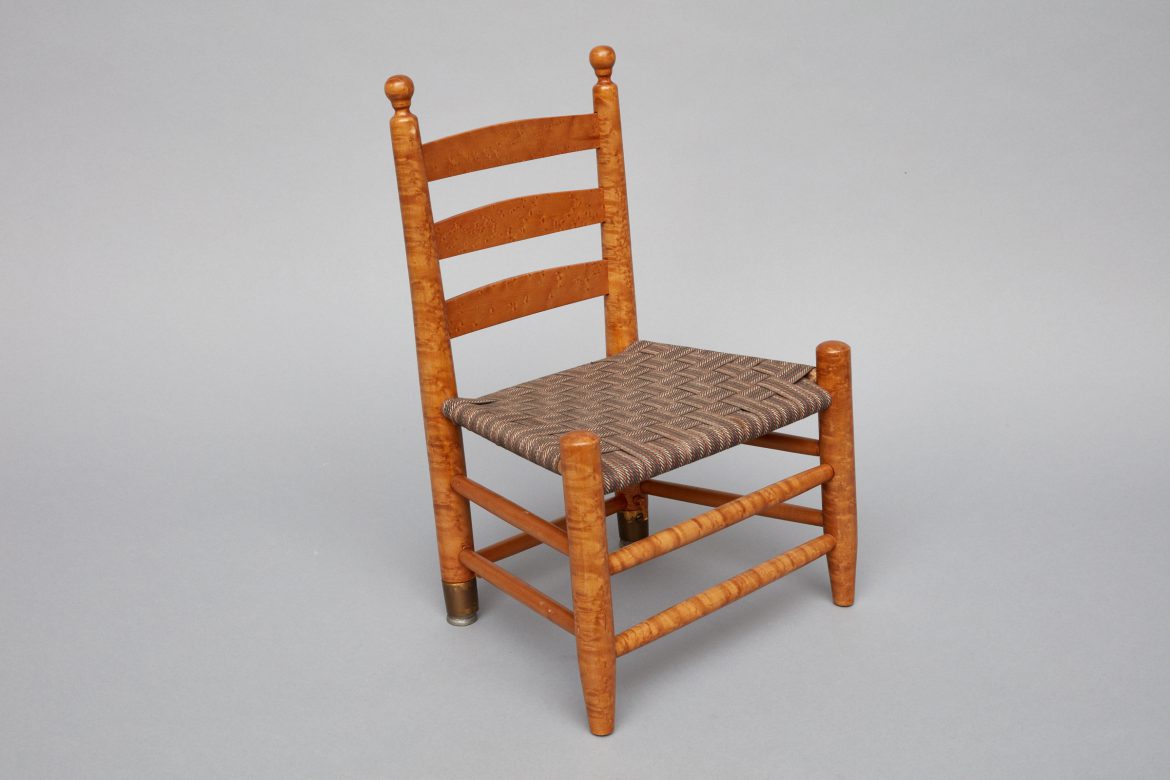
Patent Model of the Shakers’ Patent for the Tilter Button (replica). The original of this patent model is described in Expressions of Eloquence: The Jane Katcher Collection,Volume I. [The replica was made and is on loan from Timothy D. Rieman, co-author with Charles R. Muller, of The Shaker Chair.]
The Shakers were clever, design savvy, and committed to caring for their property, as demonstrated by their use of the chair “tilter.” In the fall of 1819 Freegift Wells, an elder and woodworker at the Church Family, Watervliet, New York, recorded in his diary that he, “Began to trim off & ball the chairs,” that he […]

Side Chair with Pewter Tilter Buttons, Second Family, Mount Lebanon, NY, ca. 1855, Shaker Museum | Mount Lebanon: 1950.215.1
The Shakers were clever, design savvy, and committed to caring for their property, as demonstrated by their use of the chair “tilter.” In the fall of 1819 Freegift Wells, an elder and woodworker at the Church Family, Watervliet, New York, recorded in his diary that he, “Began to trim off & ball the chairs,” that he had been making for the family. “Balling” the chairs was the term he used to describe inserting a small round wooden ball in the bottom of the back legs of chairs. The balls, flattened on their bottoms, were able to rotate within a socket in the bottom of the chair posts. The balls were held in place with a leather thong or cord passing through the bottom of the ball and then through a hole in the chair post, exiting on the side of the post where it was either tacked or wedged in its hole to keep the ball held tight in its socket. The purpose of the device was to reduce the marring of the softwood (usually pine) floor by the hardwood (usually maple or birch) chair legs when brothers or sisters, as they apparently did, leaned back in their chairs. Raising the front legs off the floor increased the pressure on the back legs and the sharp edge of the back legs often left dents in the floor. The tilters were meant to prevent this damage.

Patent Model of the Shakers’ Patent for the Tilter Button (replica). The original of this patent model is described in Expressions of Eloquence: The Jane Katcher Collection,Volume I. [The replica was made and is on loan from Timothy D. Rieman, co-author with Charles R. Muller, of The Shaker Chair.]

Model of Wooden Tilter, ca. 2004. Made by Shaker Museum|Mount Lebanon staff.

Brass Tilter Button, Second Family, Mount Lebanon, NY, ca. 1852, Shaker Museum | Mount Lebanon: 2008.19.1.
The metal tilter buttons were made in a variety of forms – some, such as a pair on a side chair in the Museum’s collection are made only of pewter, some only of brass, and some of a combination. Some are stamped with the date “1852” and one pair is stamped “Pat. 1852.” It appears that there was a lot of experimenting going on as to the best way to manufacture these new tilters, however, in the end, whichever way was thought best, a relatively small number were actually used on chairs. The survival rate is very low and in the 1870s when the Shakers continued to offer tilter buttons on their production side chairs – they returned to the wood style.